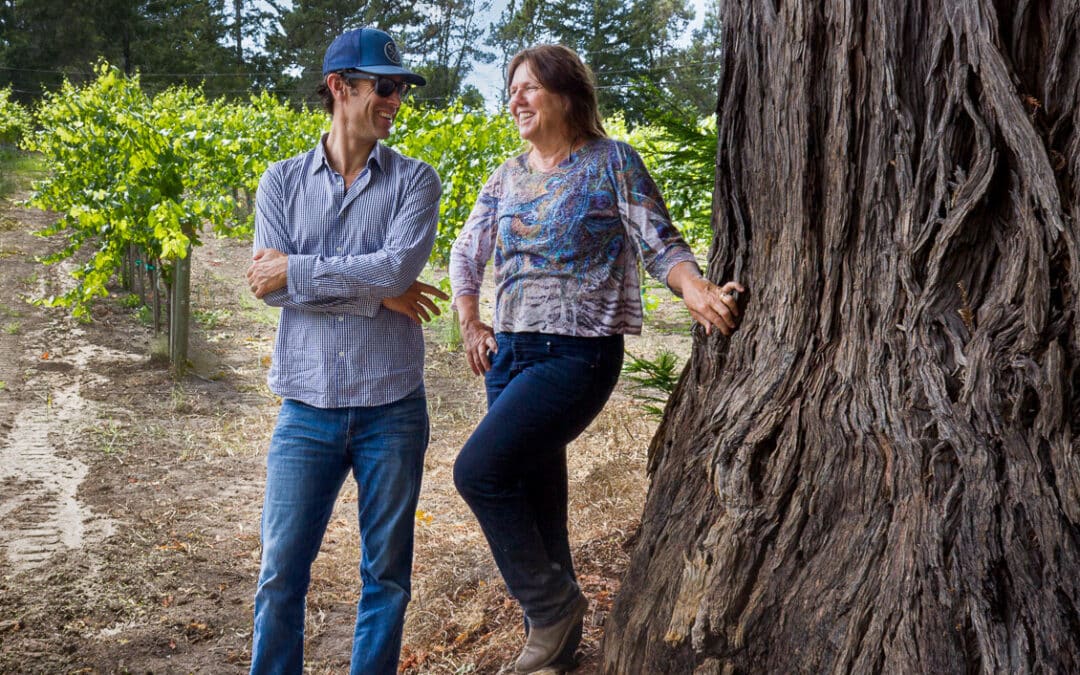Going Off Piste
Some of the most exciting “discoveries” we’ve made in the last 10-years have been in the Aptos-Corralitos region of Santa Cruz. Long-time fans of the wines grown along the coastal ridges above Saratoga (Ridge, Mount Eden, Rhys) we’ve for years been searching for fruit in this area. Aside from some early morning surfs at Steamer Lane and a couple afternoons bombing single track in the redwoods, the search was largely unsatisfying.
Our Big Break: Prudy Foxx
Then we met Prudy Foxx, a local viticultural hero known for finding neglected California vineyards and restoring them to glory. She had the keys to this elusive kingdom and fortunately for us, she was a fan of our restrained style of Chardonnay and Pinot Noir. Prudy drove us to the remote corners of the AVA and led us quite literally into the backyards of two of our most prized growers—Frank Saveria and Joe Quink (La Marisma). The transcript below is an edited version of an interview I conducted with her about the Santa Cruz Mountains.
Q: What are your core responsibilities as Vineyard Manager for La Marisma and Saveria?
Prudy: My core responsibilities are to make sure that the vineyards produce the best fruit possible for premium wine production.
Matt: We go for full expression of terroir, knowing that the Corralitos sub-area of the Santa Cruz Mountains can produce Pinot Noir that rests easily on the finest tables of the world.
Prudy: I coordinate the on-site team to perform specific cultural tasks designed to keep the fruit clean, maintain the canopy for excellent airflow, and enhance limited but available light exposure for optimal color and flavor development. I work closely with those producers to bring in fruit at optimal ripeness and then follow the progress of the wine through fermentation and aging. In this way, the winemaker and I can learn the personality of each block and improve our efforts each year as a team.
Q: How do you see the inputs you make in the vineyard relating to overall wine quality?
Prudy: I use amendments not as a direct line to the vine but as a way to support the microbial life of the soil. In this way, the microorganisms can release from the soil the minerals that the vine needs to support its fruit. It is a multi-layered process. This is very different from the idea that you put in fertilizer and force-feed the vines to grow fruit. It is why viticulture and commercial farming are often at odds with each other.
Matt: I pay attention to the physiology of the vine, from the microscopic root hairs beneath the soil through the vascular infrastructure of the vine to the fruit and tips of the vine.
Prudy: There is a very complicated set of communications that go on inside of any given vine. I make no blanket assumptions like “small vines produce the best fruit, or a tortured vine makes the best fruit.” I support balance in the vine and strive to support it so that it can grow to its natural size and production limits based on the site of origin.
Q: How is this Aptos/Corralitos area distinct from nearby sites like Mt Eden and Ridge?
Prudy: The Santa Cruz Mountains is a fascinating area for many reasons, including its unique geology. The distinct mountain range that forms the ridge between the East Side and the West side of the AVA has a completely different geology and mineral origin. Saveria Vineyard and La Marisma Vineyard both benefit from colluvial soils that have eroded down from higher parts of the west side of the mountains. These have come to rest in the lull of the gentle slopes that make up this area as the land falls off toward the sea. Marine uplift historically contributed to calcium deposits contributing to complex soil mineral profiles.
Matt: These heavier minerals and sharp-edged deposits make for excellent drainage and light thermal mass that heats up and cools down quickly, much like a cold-blooded animal.
Prudy: The marine fog keeps temperatures moderate and the morning air moist contributing to long slow ripening during the hot late summer months.
Mt. Eden and Ridge, by contrast, enjoy far greater solar radiation exposure and deep, consistent soils that hold soil temperatures and soil moisture for longer periods. They are slower to heat up and dry out, but they hold the heat longer and dry out completely. The higher elevation vineyards experience even more temperature variation than the western coastal slopes because of the uneven terrain. Even the slightest change in elevation can significantly affect fruit exposure and heat units because of gravitational drainage and cold pockets. Both areas have the potential to produce amazing wine quite distinct from one another. Despite their differences in flavor profile, they share the characteristic unique acid balance that makes up the age-worthy outstanding wines of the Santa Cruz Mountains.
Q: What makes the Santa Cruz Mountains AVA such a grand terroir?
Prudy: I think it is important to define terroir. The French like to include human influence as equal in importance to the climate and soils of an area.
Matt: As we evolve as a serious wine-producing culture, the contributing factors of (1) temperate coastal influence, (2) excellent soil drainage, (3) varied mineralogy, and (4) conscious viticulture will help the Santa Cruz Mountains emerge as a world player in great wine production.
Prudy: The balance of acidity and flavor evolving from the complex interplay of the above-named forces of terroir produce Santa Cruz wine that is complex and age-worthy. That is a wonderful combination.
Matt: Prudy, we are lucky to work with such a visionary viticulturist. Thank you for your dedication and your willingness to dispel the wisdom!
Prudy: My pleasure, Matt. I love what you guys are up to down here.

